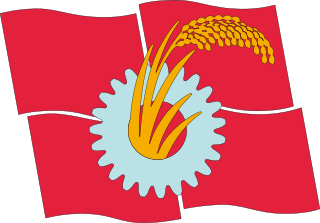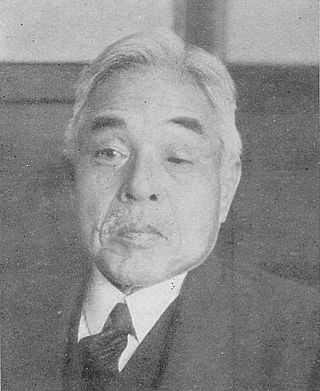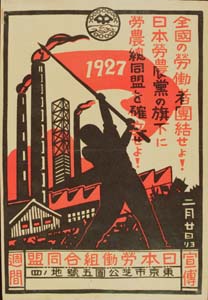Related Research Articles

The Japanese Communist Party is a communist party in Japan. Founded in 1922, it is the oldest political party in the country. It has 250,000 members as of 2024, making it one of the largest non-governing communist parties in the world. The party is chaired by Tomoko Tamura, who replaced longtime leader Kazuo Shii in January 2024.

The Japan Socialist Party was a socialist and progressive political party in Japan that existed from 1945 to 1996. The party was founded as the Social Democratic Party of Japan by members of several proletarian parties that existed before World War II, including the Social Mass Party, the Labour-Farmer Party, and the Japan Labour-Farmer Party. The party represented the Japanese left after the war, and was a major opponent of the right-wing Liberal Democratic Party.

Mosaburō Suzuki was a Japanese journalist, essayist, and socialist leader.

Socialist thought in Imperial Japan appeared during the Meiji period (1868–1912) with the development of numerous relatively short-lived political parties through the early Shōwa period. Left-wing parties, whether advocating communism or socialism, provoked hostility from the mainstream political parties, oligarchs and military alike, and many were either banned or went underground soon after formation. Although occasionally winning a seat in the lower house of the Diet of Japan, left-socialist parties played little role in the government of the Empire of Japan.

The Shakai Taishūtō was a moderate leftist political party in early Shōwa period Empire of Japan.
The Japan Socialist Party was a major Japanese political party that existed from 1945 to 1996.
The Bulgarian Social Democratic Workers Party (Broad Socialists) (Bulgarian: Българска работническа социалдемократическа партия (широки социалисти), Balgarska rabotnicheska sotsialdemokraticheska partiya (shiroki sotsialisti)) was a reformist socialist political party in Bulgaria. The party emerged from a division at the Tenth Party Congress of the Bulgarian Social Democratic Workers Party held in 1903 (the other faction forming the Bulgarian Social Democratic Workers' Party (Narrow Socialists)). The 'Broad Socialist' faction had appeared inside the pre-split party around 1900, when Yanko Sakazov had started the magazine Obshto delo ('Common Action'). The Broad Socialists, analogous to the Mensheviks in the Russian Social Democratic Labour Party, argued in favour a broad social base of the party and broad class alliances.

The Japan Labour-Farmer Party was a socialist political party in Japan between December 1926 and December 1928. During its existence, it occupied a centrist position in the divided socialist movement.

The Japan Labour Union League was a trade union centre in Japan. It was founded in December 1926, following the split in the Social Democratic Party as the leaders of the dissident Japan Labour-Farmer Party were expelled from the social-democratic Japan Federation of Labour (Sodomei) trade union centre. The Japan Labour Union League functioned as the trade union wing of the Japan Labour-Farmer Party, and had around 5,000-6,000 members.

The Labour-Farmer Party was a political party in the Empire of Japan. It represented the left-wing sector of the legal proletarian movement at the time. Oyama Ikuo was the chairman of the party. At the time the party was banned by the government in 1928, it was estimated to have around 90,000 members in 131 local organizations. The party was supported by the Hyōgikai trade union federation and the Japan Peasant Union.
The Proletarian Masses Party was a short-lived political party in Japan. It was founded on July 22, 1928 by the Rōnō faction. Suzuki Mosaburō became the general secretary of the party. Yamakawa and Sakai Toshihiko functioned as 'elder' advisors in the party. Other prominent founders of the party were Kuroda, Inamura Junzo and Okada.
The Japan Farmers Party was a political party in Japan between 1926 and 1928. It represented a rightist tendency amongst the proletarian parties in the country at the time. The party had a nationalist orientation.
The Social Democratic Party was a political party in Japan between 1926 and 1932. Amongst the three main proletarian parties in Japan at the time, the Social Democratic Party occupied a rightist position.
The Labour-Farmer Masses Party was a political party in Japan. It was founded in January 1929 by Mizutani Chozaburo, a former associate of the Labour-Farmer Party leader Oyama Ikuo. Mizutani criticized Oyama Ikuo for being too open towards a merger with the centrist sectors of the socialist movement. The Labour-Farmer Masses Party was largely confined to Kyoto. The party was one of the founders of the United Proletarian Party Front in 1929.
Nihon Rōdō Kumiai Hyōgikai was a trade union centre in Japan which has been operational since 1920.
The Farmer-Labour Party was a short-lived socialist political party in Japan. The party was the first of the proletarian parties that emerged in the country after the enactment of the Universal Manhood Suffrage Law in 1925, which gave the vote to all males 25 years or older. The party was banned by the Japanese government just a few hours after its foundation.
Proletarian internationalism, sometimes referred to as international socialism, is the perception of all proletarian revolutions as being part of a single global class struggle rather than separate localized events. It is based on the theory that capitalism is a world-system and therefore the working classes of all nations must act in concert if they are to replace it with communism.

The Japan Masses Party was a proletarian political party in Japan.
Kakushin seitō(革新政党), meaning reformist political parties or progressive political parties, is an umbrella term used in Japan to refer to a variety of left-leaning political parties generally viewed as "anti-conservative." In the postwar period, it has generally been applied to democratic socialist, social democratic and socially progressive parties that seek to uphold Article 9 of the Japanese Constitution. Japan's "progressive parties" are basically opposed to constitutional amendments led by right-wing conservatives, so they are partly in solidarity with moderate liberal parties. "Kakushin" parties have been considered progressive or radical-liberal forces.
References
- ↑ Mackie, Vera. Feminism in Modern Japan . Contemporary Japanese society. Cambridge: Cambridge University Press, 2002. p. 60
- 1 2 3 Mackie, Vera C. Creating Socialist Women in Japan: Gender, Labour and Activism, 1900–1937 . Cambridge: Cambridge University Press, 2002. p. 132
- ↑ Beckmann, George M., and Genji Okubo. The Japanese Communist Party 1922–1945 . Stanford, Calif: Stanford University Press, 1969. p. 103
- 1 2 3 4 International Labour Office. Industrial Labour in Japan . Japanese economic history, 1930–1960, v. 5. New York: Routledge, 2000. pp. 113–114
- ↑ University of Chicago. Economic Development and Cultural Change . [Chicago]: University of Chicago Press, 1952. p. 197
- 1 2 3 4 Large, Stephen S. Organized Workers and Socialist Politics in Interwar Japan . Cambridge [Cambridgeshire]: Cambridge University Press, 1981. p. 124
- 1 2 Duus, Peter, John Whitney Hall, and Donald H. Shively. The Cambridge History of Japan 6 The Twentieth Century . Cambridge u.a: Cambridge Univ. Press, 1988. p. 58
- ↑ Banno, Junji. The Political Economy of Japanese Society . Oxford: Oxford University Press, 1997. p. 239
- ↑ Banno, Junji. The Political Economy of Japanese Society . Oxford: Oxford University Press, 1997. 242
- 1 2 Large, Stephen S. Organized Workers and Socialist Politics in Interwar Japan . Cambridge [Cambridgeshire]: Cambridge University Press, 1981. p. 125
- ↑ Scalapino, Robert A. The Japanese Communist Movement, 1920–1966 . Berkeley: University of California Press, 1967. p. 35
- ↑ Beckmann, George M., and Genji Okubo. The Japanese Communist Party 1922–1945 . Stanford, Calif: Stanford University Press, 1969. p. 173
- ↑ International Labour Office. Industrial Labour in Japan . Japanese economic history, 1930–1960, v. 5. New York: Routledge, 2000. p. 114
- 1 2 Large, Stephen S. Organized Workers and Socialist Politics in Interwar Japan . Cambridge [Cambridgeshire]: Cambridge University Press, 1981. p. 108
- ↑ Barshay, Andrew E. State and Intellectual in Imperial Japan: The Public Man in Crisis . Berkeley: University of California Press, 1989. pp. 187–188
- 1 2 Fukui, Haruhiro. Political Parties of Asia and the Pacific . The Greenwood historical encyclopedia of the world's political parties. Westport, Conn: Greenwood Press, 1985. p. 1243
- ↑ Large, Stephen S. Organized Workers and Socialist Politics in Interwar Japan . Cambridge [Cambridgeshire]: Cambridge University Press, 1981. p. 145
- ↑ Large, Stephen S. Organized Workers and Socialist Politics in Interwar Japan . Cambridge [Cambridgeshire]: Cambridge University Press, 1981. pp. 154–155